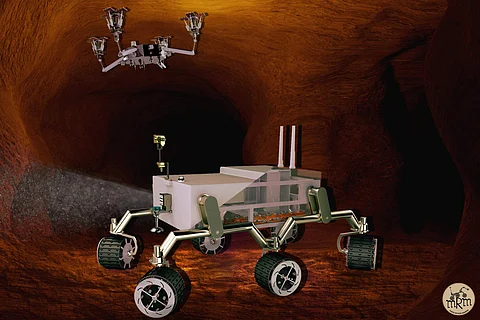

Lava tubes are not peculiar to Earth. Just like how these underground cave formations hold the secrets of our planet and its evolution, those on Mars do just the same. And so, the International Rover Design Challenge (IRDC), organised by the Mars Society South Asia (MSSA), asked participants from 32 teams across four countries to design a rover that could venture closer to harvesting these pockets of invaluable information from Mars. The competition, which was in its second year in 2021, announced its winners recently and Manipal Institute of Technology's Mars Rover Manipal (MRM) team bagged the third prize for their design.
The youngsters worked remotely for the most part for the project, thanks to the pandemic
Team leader of MRM, Jyotishka Duttagupta, who is a third-year student of Mechanical Engineering, said that the team of 30 made up of second and third-year Engineering across various streams worked on the project for about a year. The hypothetical problem statement given to the participants involved exploration of Martian lava tubes, which are being currently researched by NASA, and Jyotishka says that these can be a potential clue about habitation on Mars because they are protected from most of the factors that make Mars inhabitable.
"In the first meeting, our focus was to channel all the experience that the group has garnered over the last seven years into a solution that we can present at the competition. We were required to submit not just a live presentation of the design, but also a 10-second illustration-based video of the design and a detailed report," shares Jyotishka. Care was taken to ensure that the report was grounded in technology and research and had over 70 citations. They had to shift to a lower grade software with the video as they were all working remotely. "We adapted well, we started collaborating online and started having hours-long meetings online to discuss and develop the design," he says.
They are currently preparing for seven different international competitions, and are engaged in nine research and development projects
MRM members were invited back to the campus earlier than other students to work on the implementation of the design in their workshop, just in time to start building their rover for 2022, and Jyotishka believes that their team is well-versed in manufacturing and fabrication of the design in the form of models. This will be presented at the IRDC's third edition, as well as the University Rover Challenge 2022, which is to be held next June in Utah, conducted by the Mars Society. The judges from that competition will include a panel of scientists from NASA.
On September 24 2021, Mangalyaan completed eight years on Mars. It was scheduled to only last for six months, when launched in 2014 by ISRO
Missions to Mars and the Moon have incited awe and amazement in our collective imagination. India's Mangalyaan mission of 2014 arrested the curiosity of one Atharv Gupta of MIT, who then set up the Mars Rover Manipal project in the institute, which has become a hub for students from various streams to build on their inquisitiveness and understanding of the Red Planet. The project, Jyotishka says, was founded to actively explore the application of Robotics in the arena of space missions. Students who sign up for the project are engaged in a nine-months training programme. In fact, the founder of the IRDC, Sagar Dhaka, was a former member of Mars Rover Manipal, from the 2019 batch.
MRM consists of 49 members in all, who are divided into two core teams of research and competitions
Jyotishka, who always had an interest in tinkering with Robotics, first joined the MRM as part of the Mechanical Design and Manufacturing Team. He has been working on the suspension of the rover, which helps it adapt to the rocky terrain on Mars, and on the robotic arm that is attached to the rover. The project is divided into two teams that focus on core research and competitions, respectively, and MRM has been winning international competitions since its inception eight years ago.
